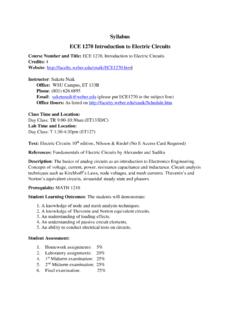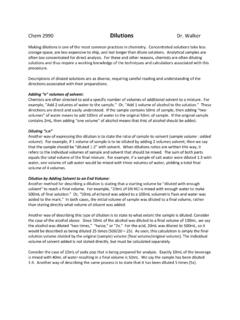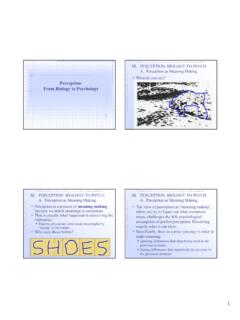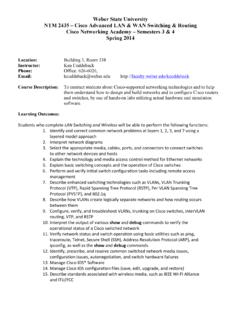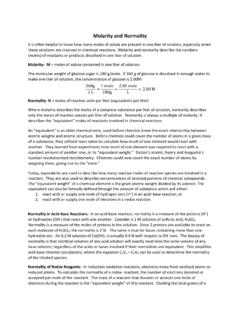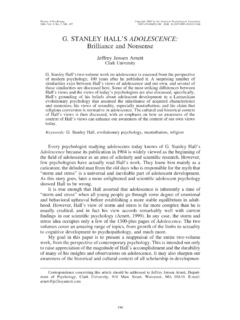Transcription of Theoretical Perspectives on Adolescence Adolescent ...
1 11 Theoretical Perspectives on Adolescent DevelopmentBased on the chapter by Lightfoot and Amsel Adolescenceis defined as a transition between childhood and maturity, one that begins in puberty and ends with the adoption of culturally defined adult responsibilities and social roles. Advantages of the Definition Multiple Processes. Focus on changes in a range of processes. There are changes not only in biological (puberty) but also in social relations (adult social roles and responsibilities). I. INTRODUCTIONA. Definition of Adolescence Advantages continued Socio-cultural context. Focus on cultural context in becoming mature. Imagine what it might be an Adolescent today vs. 100-years ago in Utah. Which time would it be easier? Interactionist: Focus on an interaction between biological and social factors associated with Adolescence . The physical changes adolescents faced during puberty interact with the socio-cultural context in which they find themselves. I. INTRODUCTIONA. Definition of Adolescence These issues found in the founding mothers and fathers of Adolescence : G.
2 Stanley Hall, Sigmund Freud, and Margaret Mead. To Hall, adolescents experience an evolutionarily-shaped, biologically process of storm and stress Published the 2 volume book on Adolescencein 1904. To Freud, the task of Adolescence is to balance biological urges with cultural expectations. Development ends in Adolescence . Mead identified the role of culture in minimizing Adolescent disturbances found in the USA. Published Coming of Age in Samoain INTRODUCTIONB. Theories of Adolescent Development2 Since its founding in 1904, theories of Adolescence have grown and become more interdisciplinary. Theories of Adolescence had employed ideas from Anthropology to Zoology. In its broadest sense, a theory is like a visitor s guidebook to a new city The guide, like a theory, minimizes ignorance by helping you notice relevant sights, important features, and interesting places to observeI. INTRODUCTIONB. Theories of Adolescent Development Two complementary functions of scientific theories: Explanation and prediction.
3 Explanationsmake use of Theoretical ideas in order to understand how and whyparticular events and outcomes occur. For example, Margaret Mead explained the storm and stress of adolescents growing up in the United States as due to their development within a discontinuous culture that requires a sudden transition to mature behavior. Predictions, in contrast, are used to test theories by making use of Theoretical ideas to anticipate the likelihood of particular events and outcomes in certain conditions. For example, Mead s theory generates the testable prediction that adolescents growing up in discontinuous societies will experience significantly more stress than those growing up in continuous INTRODUCTIONC. Functions of Theories Theories of Adolescence are distinct in their explanations and predictions But some theories shares with others certain broader assumptions about how and why Adolescent behaviors emerge and change. These broader assumptions shared by theories are associated with an image of adolescents.
4 Theories project an image of adolescents as biologically immature juveniles architects of their thinking and reasoning cultural INTRODUCTIOND. Theoretical Images of Adolescents Image of youthful enthusiasm, high energy, gawky clumsiness, and habitual foolishness. Like the ugly duckling until biological processes transforms it into a mature and majestic swan. The biological process of transformation is linked to evolutionary mechanism which drive changes to fit into particular contexts. Images of adolescents as immature juveniles, hostage to biological processes, abound in media. Teens portrayed as not responsible for being biologically incapable of resisting temptations, making good choices, controlling their emotions, or planning their futures, which are normal parts of teen BIOLOGICALLY IMMATURE JUVENILESA. Images of Immaturity3 Adolescents are juvenile because of a long slow process of development. Development is an evolutionary-shaped, genetically-controlled biological process of adaptingto ones environment.
5 Adaptation produces changes in functioning, resulting in the organism becoming more suited to his or her environment ( , thriving and reproducing) The adaptations of central importance during Adolescence for all species include becoming prepared for reproduction and separated from parents (Weisfeld, 1999).II. BIOLOGICALLY IMMATURE JUVENILESB. Sources of Immaturity Adolescent immaturity can be understood in this light of evolutionarily imperatives. Concerns with popularity and attractiveness may be adaptive behaviors to gain the status and attention required for mating and reproduction. Novelty seeking and risk taking may also be attempts to gain status and maximizing reproductive success. Critical brain changes are adaptations that support the planning and other thinking skills necessary for separating from parents and starting one s own household. II. BIOLOGICALLY IMMATURE JUVENILESB. Sources of Immaturity Adaptation requires a distinction between an individual s genotype and phenotype.
6 An individual s genotype is the exact genetic makeup the particular set of genes that the individual has inherited. Knowledge of the genotype comes from studying the individual s DNA which genes are compose, The phenotyperepresents all the observable physical, behavioral, and psychological traits that the individual actually develops. Knowledge of the phenotype comes from studying the individual s body and behavior. II. BIOLOGICALLY IMMATURE JUVENILESC. Genotype and Phenotype Although related, genotypes and phenotypes do not necessarily coincide. Identical twins have precisely the same genotype, but their phenotypes even their fingerprints are never completely identical, and indeed become increasingly different as the twins age. Phenotypes are influenced by an individual s environment in addition to his or her BIOLOGICALLY IMMATURE JUVENILESC. Genotype and PhenotypeGEP4 Darwin s natural selection is premised by the genotype-phenotype distinction Individuals with phenotypes that are adapted to their particular environment ( , whose traits are well fitted to the environment) have an greater chance of surviving and reproducing In contrast, individuals whose phenotypes are not adaptive either do not survive or are less reproductively successful.
7 The fact that the odds of survival are greater for species better fitted to their environment gave rise to the well-known phrase, survival of the BIOLOGICALLY IMMATURE JUVENILESC. Genotype and Phenotype Natural selection requires phenotypic variation Heritable variations of particular phenotypes that have survival value for the individual and species Consider the phenotypic trait of height in trees growing in a crowded forest. Taller trees may get more sun than shorter trees and are therefore likely to produce more seeds (offspring). Over many generations, trees with genes for taller height will greatly outnumber those with genes for shorter height. Variationsof phenotypic traits that are adaptive in the existing environmental conditions will increase in the species as a whole while those that are maladaptive will quite literally die BIOLOGICALLY IMMATURE JUVENILESD. Phenotype Variability and Plasticity The extent a phenotype is open to influence of the environment is phenotypic plasticity.
8 Low plasticity traits include eye color. Genotype is strongly influential and the phenotype develops in a highly predictable manner, irrespective of environmental factors. High plasticity traits include intellectual abilites. Genotype less influential so the phenotype is affected by the environment and develops less predictably Canalized traits follow a strictly defined path, regardless of most kinds of environmental and genetic BIOLOGICALLY IMMATURE JUVENILESD. Phenotype Plasticity and Plasticity Together, plasticity (variability) and canalization (stability) have tremendous power in organizing children s development. Young adolescents adapt by being innovative, even risky in seeking out new experiences which is seen in adolescents ranging from mice to monkeys. It serves to enhance status and resources all of which are important for mate selection and reproduction. Such behavior is affected by both the species genotype and socio-cultural conditions resulting in variation in the degree to which risk taking is expressed in certain times and BIOLOGICALLY IMMATURE JUVENILESE.
9 Genes, Environments and Development5 The environments adolescents find themselves are partially controlled by the Adolescent Niche constructionrefers to how the behaviors, activities, and choices of individuals actively shape and modify the environments in which they live. Niche construction suggests that sexual postponersand indulgers are both merely reacting to different social conditions given their evolutionary urges. Harsh and unpredictable home life make teens feel that investing in their future by acquiring education or job training is impracticable, unlikely to succeed and so don t put off fulfilling the evolutionary impulse to BIOLOGICALLY IMMATURE JUVENILESE. Genes, Environments and Development The Adolescent as biologically immature juvenilefocuses on phenotypic development. The emerging social, cognitive, emotional and physical changes across the Adolescent years constitute phenotypic expressions of genotypes that have been shaped by evolution. These emerging changes are also affected by the socio-cultural context into which adolescents live and adapt their evolutionary-shaped genotypes.
10 Understand the both the genory and the evironentare keys to understanding Adolescence fro this BIOLOGICALLY IMMATURE JUVENILESE. Genes, Environments and Development Image of adolescents designing their develop-ment like architects designing a building. Explaining adolescents behavior and development requires an appreciation of their Perspectives , This includes their personal understandings of themselves and the world above and beyond evolutionary-based biological factors and features of the social environment. Personal understandings shape adolescents activities in the world and become a springboard for them to construct new understandings when the old ones become inadequate and needs revision. III. ARCHITECTS OF THINKING & REASONINGA. Image The process of development in personal understandings and actions in the world is a dynamic one related to biological changes. Old ways of understanding oneself and relating to one s parents are quickly recognized as inadequate as adolescents cope with the physical and sexual changes associated with puberty.

